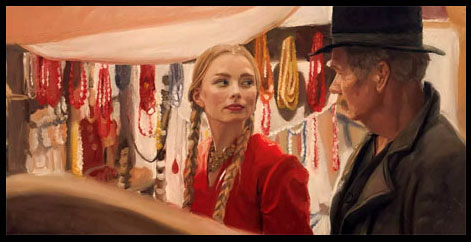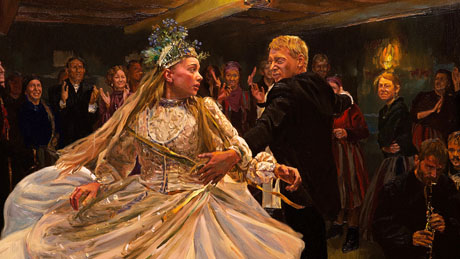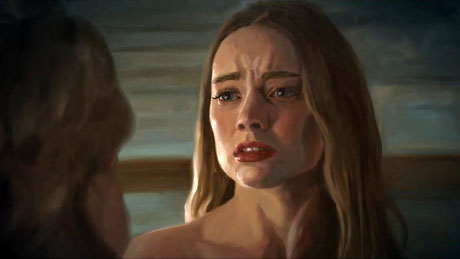
Six years after DK and Hugh Welchman changed animation and cinema forever with their Oscar-nominated, fully painted feature film Loving Vincent, about the life of iconic artist Vincent Van Gogh, the directors have created another incredible, entirely painted animated feature. The Peasants, based on the classic story, just premiered at the 2023 Toronto International Film Festival. I had the chance to screen the film and speak with the Welchmans about advancing the art form with a completely different story… and how you can own a piece of it. (This Animation Scoop Q&A was edited for length and clarity.)
Jackson Murphy: Your artistic achievements and what you’ve done for cinema is fantastic. How was it screening The Peasants at TIFF?
Hugh Welchman: Well, it was terrifying, because it was our first showing in four years of this film. It was the world premiere. No audiences have ever seen this film. We got to the end of the film and I was sitting there thinking, “We’ve made such a tough film. It’s just too tough for anyone to watch.” We had a standing ovation. And we had such incredible participation from the crowd in the questions and answers that they were even helping us answer the questions. They were so enthusiastic in wanting to be a part of the film. They were contributing answers to the questions. That was a first! (laughs) With Loving Vincent, we won 20 audience awards. We got a lot of love for that, but this was a first for us.

JM: That’s awesome. I’m so thrilled for you and that the TIFF audience got to see it. I got to see it as well [through a screener link]. There’s so much to admire about the look and the story and the performances. So DK, you started on this journey four years ago? Did you take a little break after the incredible success of Loving Vincent — and then why this story?
DK Welchman: I think it went very organically into the next project. I started to listen to the audiobook of The Peasants while I was painting a shot for Loving Vincent. There was not really a break. During the advance screenings, I started developing this in my head — this idea of adapting it. I gave Hugh the books — it’s like four books, 900 pages. He read it. It’s incredible and moved me very much in terms of my visual imagination and ideas of how to show it and translate it on the screen through the paintings. But maybe it’s too small for audiences. It’s the peasant life of 19th Century rural Poland. So I gave it to Hugh. He read it and said, “Oh my God. We have to do it.”
HW: She was the one who thought we should do it in the first place, and then when I read it, I thought, “We have to do this as an adaptation!” We wanted to do something different after Loving Vincent. We didn’t want to make “Loving Vincent 2”. Lots of people were saying, “Which artist are you going to do next?” We thought there were so many more possibilities with oil painting animation. When I read The Peasants, reading [Wladyslaw] Reymont’s descriptions of nature painted paintings in my head. It’s so poetic. It’s so descriptive and so magical. It could only be done justice in oil paintings. I was very, very keen to do it. And DK then realized it’s a national treasure. People are very protective of it. She was like, “Do we really want to put ourselves up there and out there to do it?” But we did.

Hugh and DK Welchman
JM: You’re brave filmmakers. And you are so right about the seasons and the weather. This movie is divided into the four seasons. It starts with this beautiful autumn section. Gorgeous. There’s a scene early on in a rainstorm. I was looking at it and thinking, “This looks so real. It is unbelievable.” So what are the challenges that go into painting weather and the seasons?
DKW: We designed seasons by colors. Because I come from a fine art background and my first, primary love is painting… I’m a colorist… when we were designing the film and thinking about the seasons I was like, “Okay. Let’s do these mood boards of each season and let’s limit everything to certain swatches of colors that will represent the season.” I like to have some sort of organization… and having options to explore it. That was great. The costumes and sets and backgrounds were designed with a certain palette. Then we painted with certain paintings in mind for reference and inspiration. I think painting rain in painting animation is not easy because… we only painted three frames per second.
JM: Wow.
HW: That was based on paintings of rain. Our VFX animator then took those painted raindrops and painted rain.
DKW: It’s really challenging to make a murky, rainy day look beautiful.
HW: We did that with the use of reflections. So you’re probably referring to the cabbage cart scene in the rain.
JM: Yeah.
HW: It’s an incredibly romantic scene, even though there’s mud.
DKW: But I think the rain in our story is also extremely symbolic. It’s used for these very dramatic moments. The first time Yagna and Antek fall in love with each other, there’s a rainstorm.
HW: Our film is very elemental. And the great thing about oil painting animation is you can intensify nature. That feeling of being in a rainstorm, with the tools of oil painting, you can create an intense feeling of a thunderstorm or of experiencing a summer forest or the endless wheat fields. You can really encapsulate that for people — the feeling they have on holiday and they see these fields of sunflowers. And that stays in their minds. That’s what we always want to create with oil painting animation — that intense, subjective feeling.

JM: And there are a lot of intense scenes in the movie, when it comes to the weather and intense joyous scenes. For fans of Loving Vincent, what you’ve done here in terms of advancing the painted look in an animated feature are the dance sequences. They blew me away. There are twirls and spins, with characters going in and out. They must’ve been difficult not only to choreograph but also to actually paint. They are really well done.
DKW: Oh my God. That was the challenge. An incredible challenge. It was motion blur everywhere and paint motion blur. Motion blur in camera looks awesome but then painted in a way that still looks good but also it looks like a painting. That’s another whole thing.
HW: We had to learn about painting motion blur in this film.
DKW: I’m so glad you like the dances because these are my favorite. The whole wedding sequence: I could just watch this part of the film on loop, to be honest. I love it so much. I love the music. Our composer, the choreographer and the actors did such a great job. So many talents together.
HW: We were so restricted with Loving Vincent, partly because of budget, but also the concept was to bring portraits to life. It was very static. We really struggled with painting moving camera with Loving Vincent. We tried to restrict it as much as possible. DK was like, “Hugh, we need to be free to move the camera.” As you’ve seen, we’ve got cranes and steadicams — very dynamic sequences. And dance was part of it. We really felt like we wanted action and a flowing camera.
DKW: And it was also very important for the novel, for the story — bringing out the emotions of the book.
JM: Even Jagna early on going through the market. That is a lovely scene where she’s going through and looking at all the different foods.
DKW: Thank you! I appreciate you saying that! (laughs) That’s one of my favorite ones.
HW: That was a lot of fun to shoot. We had a steadicam guy on a crane. He came down on the crane and then he walked off the crane and followed Jagna all the way through the market.
DKW: And then poor painters had to paint it, painstakingly.
HW: When she’s going through the jewelry store. They had to re-paint every beat as she walks behind it. I think that painter needed some therapy after painting that.

JM: And the lead actress who plays Jagna, Kamila Urzedowska, is fantastic. You are with her — connected to her — every step of the way. It’s a challenging role. It’s a demanding role. What impressed you the most about what she was able to bring to this character?
DKW: I think her individuality. She brought herself. I was impressed that she wasn’t holding back. [Jagna] is very sensitive. She is a very unique character, and [Kamila] brought it all in. That’s important because that’s who Jagna was.
HW: In real life [Kamila’s] stunningly beautiful but she’s also a very different, quirky person. She writes video games and poetry. She’s a very sensitive individual. She brought that quality to the character, which we felt was a very 21st Century take on Jagna and we hope would connect with her generation — that teenagers and young women would identify with her character. We feel this film has a lot to say to young women now. She brought a particular quality that people could identify with.
JM: I think she will have a major impact on them. I can’t wait for people to see The Peasants. In the meantime, and for those who attended the TIFF screening, you saw in the end credits that you can buy and own paintings from the movie at shop.thepeasantsmovie.com. How many of them are you going to put on the website?
HW: Well, eventually about 2,000. But it will take time because a lot of them are still wet. Oil paintings take months to dry. We only have the first couple hundred from the beginning of the painting process that are on there now. When they’re dry, we’ll bring out more. We have studios in Ukraine and Serbia and they’re being shipped to our main studio in Poland. And then we can unpack them and we can put them online. We want everyone to have a piece of our art adventure on their walls.
DKW: Not everyone.
HW: Not everyone. But, like, 2,000 people. (laughs)
- INTERVIEW: Strap In For “Mars Express” - April 30, 2024
- INTERVIEW: Jeff Fowler On “Knuckles” And “Sonic 3” - April 22, 2024
- INTERVIEW: “Inside Out 2” Director And Producer On Pixar Sequel - April 16, 2024


 September 15th, 2023
September 15th, 2023  Jackson Murphy
Jackson Murphy  Posted in
Posted in  Tags:
Tags: 






